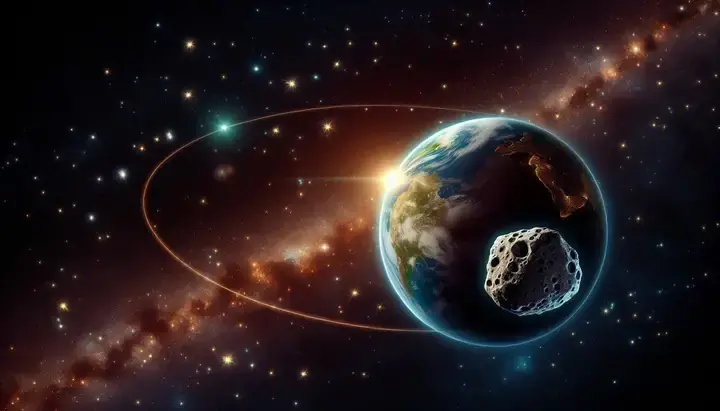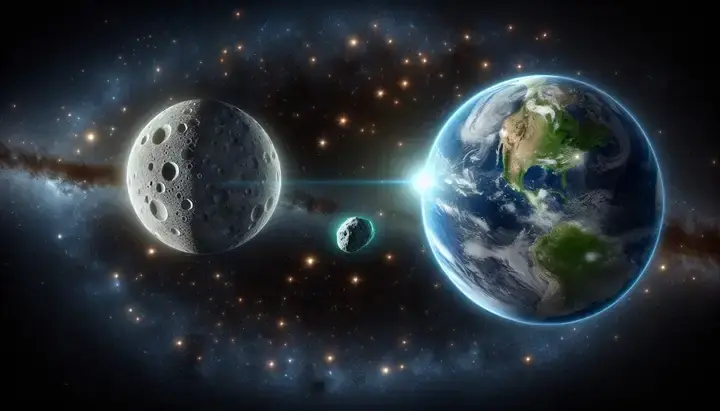2 Moons for next 2 Months: Earth’s new mini-moon
In a celestial event that has astronomers buzzing with excitement, Earth is set to welcome a new temporary satellite, the asteroid 2024 PT5, which will become a “mini-moon” for approximately two months starting September 29, 2024. Indeed, this rare occurrence provides a unique opportunity for scientists to study a near-Earth object up close and gain valuable insights into the composition and dynamics of our solar system.
The Arjuna Asteroid Belt and 2024 PT5
Specifically, the object that will be visiting Earth belongs to the Arjuna asteroid belt, a secondary asteroid belt made up of space rocks that follow orbits very similar to that of Earth at an average distance of about 1 astronomical unit (AU) from the Sun.
Carlos de la Fuente Marcos, research lead author and professor at Universidad Complutense de Madrid, explains that “Objects in the Arjuna asteroid belt are part of the near-Earth object population of asteroids and comets.“

The Capture Process and Mini-Moon Dynamics
For an asteroid to become a mini-moon, firstly, it must approach Earth at a close range of around 2.8 million miles (4.5 million km) and secondly, at a slow speed of about 2 kilometers per second. Furthermore, gravitational disturbances can cause the object’s geocentric energy to become negative, thereby allowing Earth’s gravity to temporarily capture it. Marcos notes that “This particular object will undergo this process starting next week and for about two months. It will not follow a full orbit around Earth.“
Mini-moon events can be categorized into two types: long captures, where the asteroid completes one or more revolutions around Earth, lasting one or more years; and short captures, where the object does not complete a full revolution and can last just days, weeks, or a few months. So far, science has identified two objects subjected to long captures (2006 RH120 and 2020 CD3) and three examples of short captures (1991 VG, 2022 NX1, and 2024 PT5).
Observing 2024 PT5 and Its Scientific Significance
Despite its small size (~10 meters / 33 feet), 2024 PT5 will not be visible to the naked eye. Even if you use typical amateur telescopes or binoculars, it will still be invisible. Marcos explains that “The object is too small and dim for typical amateur telescopes and binoculars. However, the object is well within the brightness range of typical telescopes used by professional astronomers.”
To observe 2024 PT5, you need a large telescope, with a diameter of at least 30 inches. You also need a special camera called a CCD or CMOS detector. These cameras help capture detailed images of objects in space.
Marcos and his team of researchers plan to observe 2024 PT5 using spectroscopy and photometry. This helps them understand the object’s movement or dynamics better. The team will publish their findings in the journal The Research Notes of the AAS.
Short mini-moon events like the one with 2024 PT5 are relatively frequent, with several occurrences per decade. Long capture episodes, on the other hand, are rare, with Earth experiencing one around every ten to twenty years. The Sun causes gravitational disturbances that eject these objects from around Earth.
The Future of 2024 PT5 and Its Potential Returns
Once 2024 PT5 finishes being a mini-moon, it will go back to an orbit around the Sun. It will still belong to the group of asteroids called the Arjuna asteroid belt. Astronomers think it might come near Earth again in January 2025. It could also come back in 2055. This shows how our cosmic neighborhood is always changing. As we get better at spotting objects in space, we might find more temporary mini-moons like 2024 PT5.
“You may say that if a true satellite is like a customer buying goods inside a store, objects like 2024 PT5 are window shoppers.” ~ Marcos
2024 PT5 will only visit for a short time. However, its arrival shows how objects like planets and asteroids move and affect each other in space. Consequently, this gives scientists a special opportunity to study and learn more about our solar system.
For more intriguing insights into other STEM-related topics, visit ENTECH Online. Explore our digital magazine dedicated to inspiring teenagers and young adults to pursue their passions in science, technology, engineering, and mathematics.
Source: https://www.space.com/earth-mini-moon-asteroid-2024-pt5






